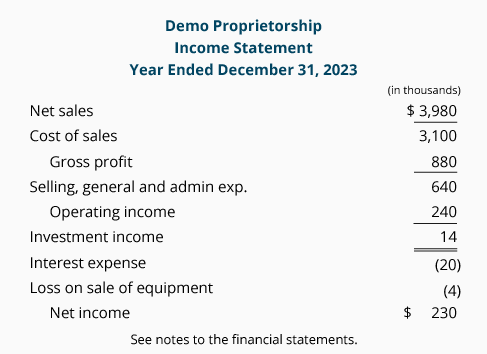Introduction to the Income Statement
Did you know? You can earn our Income Statement Certificate of Achievement when you join PRO Plus. To help you master this topic and earn your certificate, you will also receive lifetime access to our premium financial statements materials. These include our video training, visual tutorial, flashcards, cheat sheet, quick tests, quick test with coaching, business forms, and more.
Earn Our Certificate
for This Topic
When you join PRO Plus, you will receive lifetime access to all of our premium materials, as well as 10 different Certificates of Achievement.
View PRO Plus FeaturesThe income statement is one of the main financial statements of a business. Other names for the income statement include:
- Statement of income
- Statement of operations
- Statement of earnings
- Profit and loss (P&L) statement
- Consolidated statement of income (operations, earnings)
The income statement reports revenues, expenses, gains, losses, and the resulting net income which occurred during the accounting period shown in its heading. Typical periods or time intervals covered by an income statement include:
- Year ended December 31, 2023
- Year ended June 30, 2023
- Nine months ended September 30, 2023
- Three months ended March 31, 2023
- Month ended August 31, 2023
- 52/53 weeks ended February 1, 2023
The following is an outline of an income statement for a regular U.S. corporation:
Below are additional details for the lines in Example Corporation’s income statement:
Operating revenues are the amounts earned from the company’s main business activities. Common operating revenues are:
- Net sales for a retailer or manufacturer
- Service fees or service revenues for a business that provides services
Operating expenses are the expenses associated with the company’s main business activities. Common operating expenses include:
- Cost of sales for a retailer or manufacturer
- Cost of services for a service business
- Selling, general and administrative (SG&A) expenses
Operating income is the result of subtracting the company’s operating expenses from its operating revenues.
Nonoperating revenues or income, nonoperating expenses, gains, and losses result from activities outside of the company’s main business activities. Common examples for retailers and manufacturers include investment income, interest expense, and the gain or loss on the sale of equipment that had been used in the business.
Income before income tax expense is the combination of the amount of operating income and the nonoperating amounts.
Income tax expense is the federal, state, and local income taxes relating to the amounts appearing on the income statement. (The actual amount paid will likely be different, since the amount paid is based on the amounts on the corporation’s income tax returns.)
Net income is the amount of earnings remaining after subtracting the income tax expense.
Notes to the financial statements refers the reader to important information that could not be communicated by the amounts shown on the face of the income statement.
Note:
If a corporation’s shares of common stock are traded on a stock exchange, the earnings per share and the average number of shares outstanding must also be shown on the income statement.
Additional details and examples of income statements will be provided later.
Please let us know how we can improve this explanation
No Thanks




